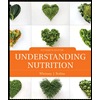
Biology: Life on Earth with Physiology Plus Mastering Biology with Pearson eText -- Access Card Package (11th Edition)
11th Edition
ISBN: 9780133910605
Author: Gerald Audesirk, Teresa Audesirk, Bruce E. Byers
Publisher: PEARSON
expand_more
expand_more
format_list_bulleted
Question
Chapter 6.5, Problem 1TC
Summary Introduction
To explain:
How the response of circulation of blood to skin and sweating both resemble and differ from the mechanism of feedback inhibition of enzymes.
Introduction:
The feedback mechanism of an enzyme is an allosteric regulation where the final product present in the sequence of reactions is accumulated in higher quantity.
Expert Solution & Answer
Want to see the full answer?
Check out a sample textbook solution
Students have asked these similar questions
ACTIVITY 10.4.2
Explain your answer briefly but concisely.
What are the steps in the energy investment phase?
2. What are the steps in the energy-yielding phase?
3. What are the enzymes involved in an irreversible reaction? How
are these enzymes being activated? What about inhibited?
4. Which step in the glycolytic pathway would ensure that glucose
is fated for glycolysis?
5. During strenuous activity, the demand for ATP in muscle tissue is
vastly increased. In rabbit leg muscle or turkey flight muscle, the
ATP is produced almost exclusively by lactic acid fermentation.
ATP is formed in the payoff phase of glycolysis by two reactions,
promoted by phosphoglycerate kinase and pyruvate kinase.
Suppose skeletal muscle were devoid of lactate dehydrogenase.
Could it carry out the strenuous physical activity; that is, could it
generate ATP at a high rate by glycolysis? Explain.
6. The transformation of glucose to lactate n myocytes releases
only about 7% of the free energy released when…
NEW
[References]
A typical fat in the body is glyceryl trioleate, Cs-H10406. When it is metabolized in the body, it combines with oxygen to produce carbon dioxide, water, and 3.022 x
10 kJ of heat per mole of fat. Write a balanced thermochemical equation for the metabolism of fat. How many kilojoules of energy must be evolved in the form of
heat if you want to get rid of 15 pounds of this fat by combustion? How many nutritional calories is this? (1 nutritional calorie = 1 x 10° calories)
nutritional calories
Submit Answer
Try Another Version
3 item attempts remaining
Previous
Next
1:40 PI
64°F Raining
6/11/20
DELL
Energy calculations
Complete this exercise related to energy calculations.
1. Baby is a 12 year old, 35 lb Beagle dog with a body condition score of 5/9. On
a routine visit to the vet to administer his annual vaccinations and get his teeth
cleaned, the owner questions whether he is giving Baby the right amount of
food. The energy density of the diet is 275 kcal ME per can.
• Calculate Baby's maintenance energy requirement (MER).
• How many cans of the diet should the owner give Baby per day?
Chapter 6 Solutions
Biology: Life on Earth with Physiology Plus Mastering Biology with Pearson eText -- Access Card Package (11th Edition)
Ch. 6.1 - Energy Unleashed Much like a cars engine, the...Ch. 6.1 - What other changes would help reduce fossil fuel...Ch. 6.1 - define energy and work?Ch. 6.1 - Could one design a roller coaster that didnt use...Ch. 6.1 - define potential energy and kinetic energy and...Ch. 6.1 - State and explain the first and second laws of...Ch. 6.2 - Energy Unleashed Marathoners rely on glycogen...Ch. 6.2 - describe how energy is captured and released by...Ch. 6.2 - Is glucose breakdown endergonic or exergonic? What...Ch. 6.2 - explain exergonic and endergonic reactions and...
Ch. 6.2 - explain activation energy?Ch. 6.3 - name and describe two important energy-carrier...Ch. 6.3 - Prob. 1TCCh. 6.3 - explain coupled reactions?Ch. 6.4 - explain how catalysts reduce activation energy?Ch. 6.4 - You may have seen the almost magical glow of...Ch. 6.4 - Can an enzyme catalyst make an endergonic reaction...Ch. 6.4 - explain how enzymes function as biological...Ch. 6.5 - describe how cells regulate the rate at which...Ch. 6.5 - Health Watch Lack of an Enzyme Leads to Lactose...Ch. 6.5 - Prob. 1TCCh. 6.5 - explain how poisons, drugs, and environmental...Ch. 6 - While vacuuming, you show off by telling a friend...Ch. 6 - Prob. 1FIBCh. 6 - Which of the following is True? a. Enzymes...Ch. 6 - Prob. 1RQCh. 6 - Refute the following: According to evolutionary...Ch. 6 - Prob. 2FIBCh. 6 - Prob. 2MCCh. 6 - Prob. 2RQCh. 6 - Can a bear use all the energy contained in the...Ch. 6 - Prob. 3FIBCh. 6 - Prob. 3MCCh. 6 - Prob. 3RQCh. 6 - Prob. 4FIBCh. 6 - Prob. 4MCCh. 6 - Prob. 4RQCh. 6 - Prob. 5FIBCh. 6 - Prob. 5MCCh. 6 - Prob. 5RQCh. 6 - Prob. 6FIBCh. 6 - Prob. 6RQCh. 6 - Prob. 7RQ
Knowledge Booster
Similar questions
- Q2. It has been estimated that two high-energy phosphate bonds must be expended to incorporate one glucose molecule into glycogen. Why is glucose stored in muscle and liver in the form of glycogen, and not as individual glucose molecules? In other words, why is it advantageous for a cell to expend metabolic energy to polymerize glucose molecules?arrow_forwardNeed help plz explain briefly Explain and give two (3) examples of the need for energy in a living organism.arrow_forwardACTIVITY 9.2.7 Answer the following briefly. 1. Why are alcoholics prone to Wernicke-Korsakoff syndrome? 2. They say niacin is not a true vitamin, why? 3. Why do some people overdose with folic acid? 4. B12 is the only one of the eight B-complex vitamins that are only found in animals. Why? 5. How do B vitamins make energy production possible?arrow_forward
- is this stement false? Intracellular concentrations in resting muscle are as follows: Fructose-6-phosphate (1.0 mM)Fructose-(1-6)-bisphosphate (10.0 mM)AMP (0.1 mM)ADP (0.5 mM)ATP (5.0 mM)Pi (10.0 mM)Under the above conditions the Phosphofructokinase reaction in muscle is more exergonic than under standard conditions.arrow_forwardACTIVITY 10.4.2 Explain your answer briefly but concisely. 1. Why is it that Individuals with thiamin deficiency have high levels of pyruvate in their blood? 2. How would riboflavin deficiency affect the functioning of the tricarboxylic acid cycle? 3. Mammalian liver can carry out gluconeogenesis using oxaloacetate as the starting material. Would the operation of the citric acid cycle be affected by the extensive use of oxaloacetate for gluconeogenesis? Explain your answer.arrow_forwardBSC1010C Enzymes & Cellular Regulation Dr. Harris Amylase is an enzyme found primarily in saliva and pancreatic secretions. It catalyzes the breakdown of starch into sugars. A Rate of reaction 0 20 60 40 Temperature, C C Rate of reaction 80 100 B Rate of reaction Enzyme concentration (Substrate concentration always in excess) Substrate concentration (Enzyme concentration constant) The above graphs (A, B & C) provide data on several factors that affect the activity and function of amylase in living organisms. 11. What variables are compared in graph A? What information can be obtained from this data?arrow_forward
- .ll KKTCELL ? 12:21 PM 67% A moodle.ciu.edu.tr IViai Keu vut uI 10.00 P Flag question Which one of the following do NOT limit the athletic performance? Select one: a. Acidosis decreases neural function due to conversion of glucose to lactate O b. Depletion of acetyl coenzyme A O c. Depletion of pyruvate d. Elevated levels of glucose O e. Build-up of inorganic phosphate Previous page Finish attempt ...arrow_forwardEnergy Storage Summary Most energy is stored as triglycerides in our adipocytes (> 15 kg, equivalent to more than 100 000 kcal !!!! Carbohydrate stored as: glycogen in liver (~150 g); most concentrated as liver is only ~2 kg! glycogen in muscle (~350 g); ~40% body mass is muscle only about 30 g of glucose is found in the blood – not much!** Protein also represents a large potential energy source (since we' re about 40% muscle). This represents about 25 000 kcal, but is obviously protected i.e. used in starvation or caloric restriction ** Consider a large meal at ~1000 kcal, and 60% carbohydrate – that's 150 grams of CHO! Yet your blood only holds 30 g!arrow_forwardQ.2 Answer ALL parts: The scheme shown below in Figure 3, outlines the fate of glucose during cellular respiration: Glucose (I) Рyruvate (II) (VI) Acetyl CoA Lactic acid Acetaldehyde (VII) Ethanol (III) Oxidative (IV) phosphorylation Figure 3: Schematic representation of the fate of glucose during respiration (a) Diagram the steps involved in the process labelled (I) in the figure given above.arrow_forward
- Question:- Explain how the total yield of ATP from the oxidation of 1 mole of glucose to CO₂ + H₂O is affected by the use of the above shuttle versus the use of the Malate Aspartate Shuttle. (above shuttle is glycerol 3-phosphate shuttle)arrow_forward385 Triacylglycerols Store Energy Q4.3 - Describe the three sources of triacylglycerols in humans and how each is transported through the blood.arrow_forwardQuestion:- Explain the significance of adiponectin, leptin, ghrelin, neuropeptide Y and PYY in regulation of fuel metabolism and appetite?arrow_forward
arrow_back_ios
SEE MORE QUESTIONS
arrow_forward_ios
Recommended textbooks for you
 BiochemistryBiochemistryISBN:9781305577206Author:Reginald H. Garrett, Charles M. GrishamPublisher:Cengage Learning
BiochemistryBiochemistryISBN:9781305577206Author:Reginald H. Garrett, Charles M. GrishamPublisher:Cengage Learning Understanding Nutrition (MindTap Course List)Health & NutritionISBN:9781337392693Author:Eleanor Noss Whitney, Sharon Rady RolfesPublisher:Cengage Learning
Understanding Nutrition (MindTap Course List)Health & NutritionISBN:9781337392693Author:Eleanor Noss Whitney, Sharon Rady RolfesPublisher:Cengage Learning

Biochemistry
Biochemistry
ISBN:9781305577206
Author:Reginald H. Garrett, Charles M. Grisham
Publisher:Cengage Learning

Understanding Nutrition (MindTap Course List)
Health & Nutrition
ISBN:9781337392693
Author:Eleanor Noss Whitney, Sharon Rady Rolfes
Publisher:Cengage Learning
